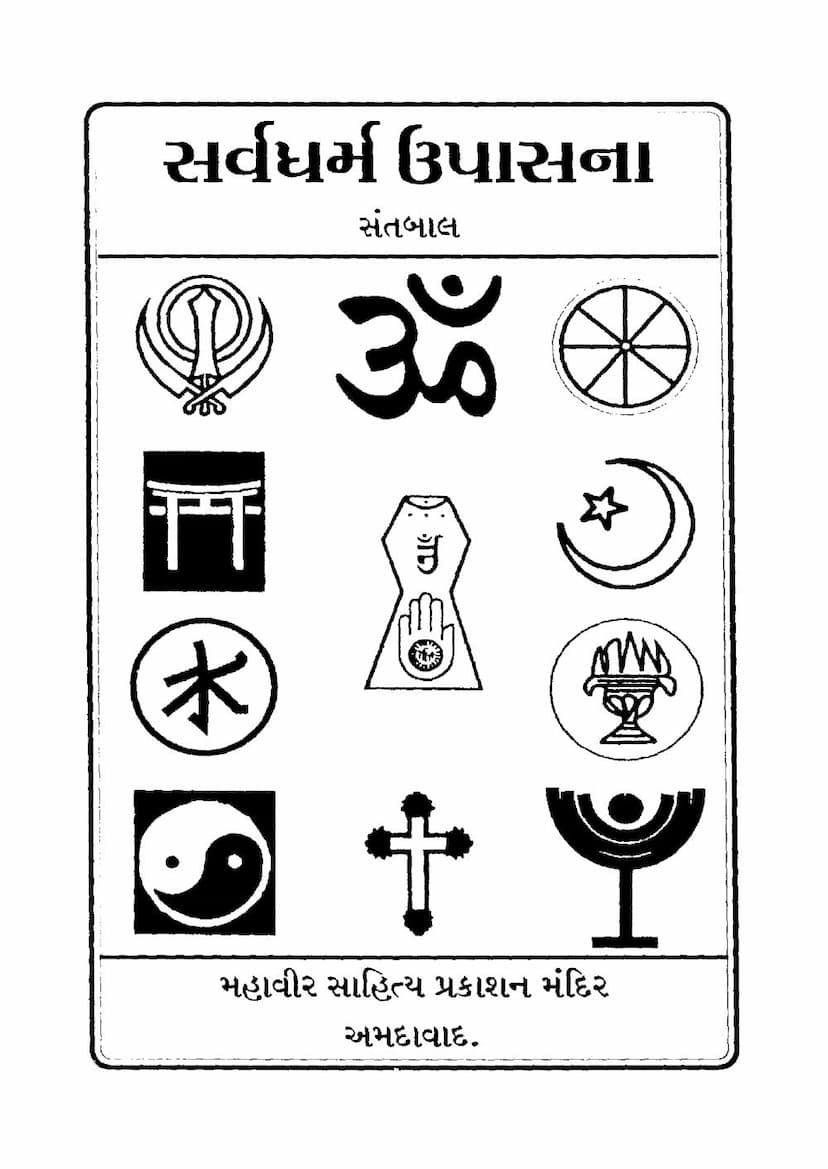Sarva Dharma Upasana
Added to library: September 2, 2025

Summary
This document appears to be a table of contents and introductory material for the book "Sarva Dharma Upasana" by Santbal. Here's a comprehensive summary in English, based on the provided pages:
Book Title: Sarva Dharma Upasana (Worship of All Religions) Author: Santbal Publisher: Mahavir Sahitya Prakashan Mandir, Ahmedabad
Overall Theme and Purpose:
The book, "Sarva Dharma Upasana," authored by the Jain monk Santbal, advocates for the concept of universal religious worship and interfaith harmony. It stems from the inspiration of the "Sarva-Dharma Upasana Mandir" (Temple of All Religions) founded by the author. The core message is that in today's world, a non-sectarian approach to prayer and worship is essential for humanity to unite.
Key Arguments and Concepts Presented:
- Universal Service as the Sole Religion: The central tenet, as stated in the opening lines, is "Our only religion is to serve all religions." This emphasizes service to all faiths as the ultimate religious duty.
- Need for Interfaith Harmony: The book addresses the growing need for religious tolerance and understanding in a world striving for unity. It highlights how historical and political factors have sometimes created divisions between religions.
- Jainism's Contribution and Universality: A significant portion of the text emphasizes the universalistic and inclusive aspects of Jainism. It argues that Jain principles, particularly anekantavada (the doctrine of manifold aspects) and ahimsa (non-violence), have influenced other religions and offer a path to universal understanding.
- Critique of Religious Narrow-mindedness and Sectarianism: The book implicitly critiques narrow-mindedness and divisive tendencies within religious communities, urging individuals to move beyond their "enclosures" or limited perspectives.
- Gandhian Philosophy and Non-Violence: The work draws heavily on the philosophy of Mahatma Gandhi, particularly his emphasis on truth, non-violence, and the integration of religion into politics. It positions Gandhi's experiments with truth and non-violence as scientific experiments in true religion.
- Dharma Beyond Rituals: The book defines "Dharma" not as a sect, ritual, or pilgrimage, but as an indispensable life-force that is woven into the fabric of individual, social, and collective existence. Without Dharma, humanity cannot survive.
- The Primacy of Truth: Truth is presented as the ultimate Dharma, the soul, and the supreme soul, connecting all living beings.
- India's Role in Universalism: India, and particularly Gujarat, is highlighted as a land with a deep-rooted tradition of universal religious sentiment, having embraced and nurtured various faiths throughout history.
- Reinterpreting Religious Practices: The book touches upon aspects like idol worship, suggesting a neutral stance and differentiating between idol worship for meditation and for devotional practices.
- The Call for a "Dharma-centric Policy": The text outlines the necessity of a "Dharma-centric policy" in all spheres of life, which includes:
- Renunciation of War and Weapons: A strong stance against armed conflict.
- Fair Distribution of Wealth and Income: Addressing issues of rent and interest, and promoting equitable economic practices.
- Communal Prayer and Moral Character: Emphasizing the importance of collective prayer to foster God-consciousness and the cultivation of moral character.
- Learning from Different Religions: The book suggests drawing ethical principles from various religions, including Zoroastrianism (peaceful conflict resolution, loyalty), Islam (brotherhood, honesty, rejecting usury, accountability), and Christianity (prayer, service, chastity, the Golden Rule).
- The Four Stages of Spiritual Progress: It proposes a progression:
- Dharma-centric Morality: Adhering to ethical principles rooted in Dharma.
- Active Spiritual Religion: Engaging in religion with active participation.
- Active Spirituality Centered on Universal Love: Extending spiritual practice to universal love for all beings.
- Liberation from Passions and Universal Love: The highest stage of freedom from afflictions and encompassing universal love.
- Jainism's Unique Contributions: Jainism's anekantavada and ahimsa are repeatedly emphasized as crucial for interfaith understanding and universal welfare. The exemplary lives of Jain figures are cited to illustrate the practical application of these principles.
- The Importance of Institutions: The book stresses the role of institutions in societal transformation, echoing Gandhi's belief in building society through organized efforts. The "Bhal Nalkantha Experiment" is mentioned as an example of such work.
- A Call to Action: The book concludes with a call for readers to actively participate in the mission of "Sarva Dharma Upasana," embracing the principles of interfaith harmony and universal service.
Introductory and Concluding Remarks:
- Foreword by Kaka Kalelkar: Highlights the book's aim to demonstrate Jainism's universality and encourage readers to move beyond sectarian boundaries. He praises Santbal's efforts in bridging religious divides.
- Publisher's Note: Mentions the book's significance as a focal point of Santbal's thought and reiterates the opening line of service to all religions.
- Concluding Prayer: A prayer composed by Santbal, paying homage to prominent spiritual figures from various traditions (Mahavir, Buddha, Rama, Krishna, Jesus, Muhammad, Zarathustra), reinforcing the theme of universal reverence.
- Gandhi's Quote on Prayer: A final quote from Gandhi emphasizes the personal nature of prayer, its role in self-reflection and seeking forgiveness, and the ultimate goal of realizing God within.
In essence, "Sarva Dharma Upasana" is a philosophical and spiritual treatise by Santbal that champions a synthesized approach to religion, drawing inspiration from Jainism and Gandhian ideals, to foster a harmonious and unified global community.